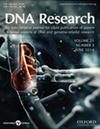Chromosomal-level genome assembly of the orchid tree Bauhinia variegata (Leguminosae; Cercidoideae) supports the allotetraploid origin hypothesis of Bauhinia
IF 3.9
2区 生物学
Q1 GENETICS & HEREDITY
引用次数: 1
Abstract
Abstract Cercidoideae, one of the six subfamilies of Leguminosae, contains one genus Cercis with its chromosome number 2n = 14 and all other genera with 2n = 28. An allotetraploid origin hypothesis for the common ancestor of non-Cercis genera in this subfamily has been proposed; however, no chromosome-level genomes from Cercidoideae have been available to test this hypothesis. Here, we conducted a chromosome-level genome assembly of Bauhinia variegata to test this hypothesis. The assembled genome is 326.4 Mb with the scaffold N50 of 22.1 Mb and contains 37,996 protein-coding genes. The Ks distribution between gene pairs in the syntenic regions indicates two whole-genome duplications (WGDs): one is B. variegata-specific, and the other is shared among core eudicots. Although Ks between gene pairs generated by the recent WGD in Bauhinia is greater than that between Bauhinia and Cercis, the WGD was not detected in Cercis, which can be explained by an accelerated evolutionary rate in Bauhinia after divergence from Cercis. Ks distribution and phylogenetic analysis for gene pairs generated by the recent WGD in Bauhinia and their corresponding orthologs in Cercis support the allopolyploidy origin hypothesis of Bauhinia. The genome of B. variegata also provides a genomic resource for dissecting genetic basis of its ornamental traits.兰树紫荆(bahinia variegata)染色体水平基因组组装的研究支持紫荆属异源四倍体起源假说
摘要:豆科6个亚科之一的Cercidoideae包含染色体数为2n = 14的Cercis属和染色体数为2n = 28的所有属。提出了该亚科非茜草属共同祖先的异源四倍体起源假说;然而,没有从尾蠓科获得染色体水平的基因组来验证这一假设。在这里,我们进行了紫荆花染色体水平的基因组组装来验证这一假设。组装后的基因组全长326.4 Mb,其中支架N50为22.1 Mb,包含37996个蛋白编码基因。同源区基因对间的Ks分布表明存在2个全基因组重复(WGDs): 1个是异芽甘蓝特有的,2个是核心株共有的。虽然紫荆花中最近的WGD产生的基因对之间的k值大于紫荆花与紫荆花之间的k值,但在紫荆花中未检测到WGD,这可以解释为紫荆花与紫荆花分化后进化速度加快。最近WGD在紫荆花中产生的基因对及其在紫荆花中相应同源物的Ks分布和系统发育分析支持紫荆花的异源多倍体起源假说。花椒的基因组也为解剖花椒观赏性状的遗传基础提供了基因组资源。
本文章由计算机程序翻译,如有差异,请以英文原文为准。
求助全文
约1分钟内获得全文
求助全文
来源期刊

DNA Research
生物-遗传学
CiteScore
6.00
自引率
4.90%
发文量
39
审稿时长
4.5 months
期刊介绍:
DNA Research is an internationally peer-reviewed journal which aims at publishing papers of highest quality in broad aspects of DNA and genome-related research. Emphasis will be made on the following subjects: 1) Sequencing and characterization of genomes/important genomic regions, 2) Comprehensive analysis of the functions of genes, gene families and genomes, 3) Techniques and equipments useful for structural and functional analysis of genes, gene families and genomes, 4) Computer algorithms and/or their applications relevant to structural and functional analysis of genes and genomes. The journal also welcomes novel findings in other scientific disciplines related to genomes.
 求助内容:
求助内容: 应助结果提醒方式:
应助结果提醒方式:


